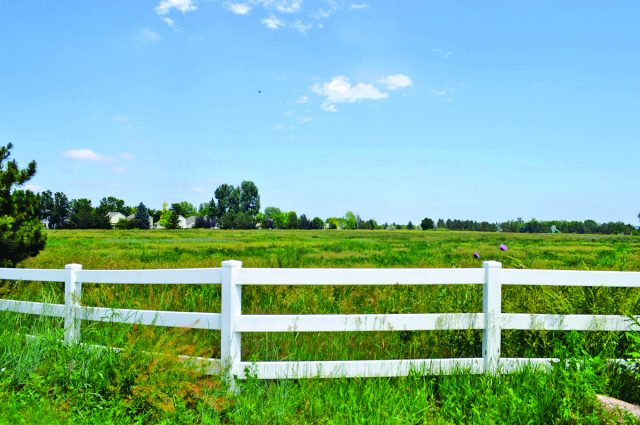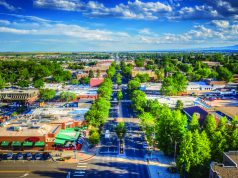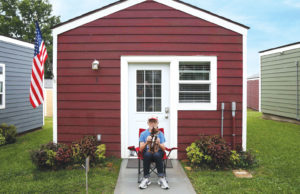
When Vic Pizzo moved into a southwest Longmont neighborhood five years ago, it quickly became home.
He calls Clover Creek a “nice place to live” — the local kids who play on the streets remind him of his childhood neighborhood. The nearby path running along a swath of prairie is a great place to walk his dog and look at the distant mountains.
In a city that’s grown by just over 12,000 residents since 2010, this area on the edge of Longmont is quiet, less developed. But that could change soon.
On July 6, the Boulder County Commissioners will vote to end a 40-year-old conservation easement over the Kanemoto Estates prairie, located less than 1,000 feet south of Pizzo’s neighborhood. If the easement ends, the city of Longmont will move one step closer to transforming the 38-acre plot into a “100% attainable” housing development named Somerset Village.
The review process was initiated by the landowner and developer Lefthand Ranch LLC, requesting to terminate the easement, annex the land into Longmont and develop a residential neighborhood.
Some say the parcel is an ideal place for Longmont to expand as it attempts to meet increasing demand from a growing population and fewer residential development sites.
David Emerson, executive director of Habitat for Humanity of the St. Vrain Valley, hopes to build homes for the organization on the property if the opportunity arises. He says the area needs more affordable housing.
“We’re just trying to bring in the voice of those who are working in our community who can’t afford to buy a home,” he says.
But other Longmont residents, like Pizzo, have a different perspective.
Keep Airport Road Environmental & Safe (KARES) is a coalition of 70 community members staunchly opposed to ending the easement. While members live across the county, many of them live in the Clover Creek subdivision adjacent to Kanemoto Estates. They’ve raised more than $14,000 to support hiring a legal team.
“It will absolutely destroy the peace of the neighborhood,” says Pizzo, bringing more traffic and congestion. If the development continues, Pizzo says he’ll move out.
In a county with more than 100,000 acres of open space, a booming population and a dearth of affordable housing, the argument around developing the Kanemoto Estates easement is the latest installment in an ongoing debate around development versus conservation, with all the trappings of a good Boulder County land-use argument: confusion, NIMBYism and minute detail.
Preserving land?
The nearly 40-acre Kanemoto Estates property is located on the east side of Airport Road, half a mile north from the intersection of Airport Road and Diagonal Highway (8702 N. 87th St.) in unincorporated Boulder County.
The conservation easement was established in 1982 between the Kanemoto family, who owned the land at the time, and Boulder County Parks and Open Space because the Kanemotos wanted to build another home on the property. Boulder County land-use policy required 75% of the property be set aside to preserve agricultural land through a conservation easement.
This created three parcels on the Kanemoto Estates subdivision — two tracts with residential homes totalling just under 10 acres, and an approximately 29-acre lot with a non-urban planned unit development (NUPUD) conservation easement.
A conservation easement is a voluntary legal agreement between a landowner and a qualified holder, such as a land trust or government agency, to restrict use on the property to protect natural features, agricultural potential or historical significance.
Boulder County’s conservation easements protect more than 40,000 acres and nearly 850 private properties. On its website, the county says it “holds hundreds of conservation easements that are designed to remain in effect for perpetuity.”
But the Kanemoto Estates easement is one of 133 across the county that include language allowing the easement to end in favor of development — which will be decided by the Boulder County Planning Commission and the County Commissioners.
Randall Weiner, a lawyer with Weiner & Cording representing KARES, says a common misconception is that conservation easements will be protected in perpetuity.
Members of the KARES group claim residents near Kanemoto Estates were wrongly informed, either by city or county staff or realtors, that the conservation easement would last forever.
Joe and Cheryl Stasiak bought their Clover Creek home 15 years ago with that understanding. When they found out the easement could be developed, they were “surprised and dismayed.”
“This was wrong to start with, to put the word conservation on something that wasn’t, according to the city and county, intended to be conserved at all,” says Joe, who is a member of KARES.
If commissioners vote in favor of termination, it wouldn’t be the first time. The county told Boulder Weeklyabout four other properties near Longmont where conservation easements were ended in favor of development, amounting to nearly 200 acres of additional subdivisions.
Dale Case, director of Boulder County Community Planning and Permitting, says there have been “several” other easements terminated over the years as Longmont annexed land, without the county’s involvement.
If the county commissioners decide to end the easement on Kanemoto Estates, the developer will pay the county $2.3 million. The county has been paid once before to end an easement: nearly $2 million to develop the area northeast of North 79th Street and Plateau Road in Longmont known as Lane Farms. Community backlash was similar, with residents forming an opposition group that argued high-density urban housing development on the Lane Farms property wouldn’t be compatible with the neighborhood’s rural character.
The county says payment from the developer would be used to acquire more open space.
‘A comprehensive view’
Kanemoto Estates is attractive for development because it’s already within Longmont’s planning area and could keep development clustered to eliminate sprawl. The county maintains that terminating the easement aligns with the Boulder County Comprehensive Plan (BCCP) and various intergovernmental agreements with Longmont, which has identified the property as a future development site since 1996.
But a letter to the county commissioners from Weiner & Cording, the law firm representing the KARES group, argues the easement shouldn’t be terminated for multiple reasons. First, they say comments by county staff in support of the termination are “unsupported legally.” The legal team also argues ending the easement would be inconsistent with some of the goals and land-use regulations set out in the BCCP. Finally, they claim the easement predates now-expired intergovernmental agreements that establish development plans for the area.
“It is precisely when the development pressures are great that the county commissioners should fulfill their fiduciary obligations to maintain the conservation easements already in place,” the letter says.
While language in the easement contract suggests termination is possible in favor of development, the subdivision plat, signed by Jimmy and George Kanemoto on April 21, 1982, includes a dedication of improvements on the property “to the use of the public forever.”
Boulder County Commissioner Ashley Stolzmann says these land-use discussions are “a really complicated topic.”
“Having a comprehensive view of where we want growth to occur and where we want preservation to occur is so important,” she says. “And that’s what our comprehensive plan strives to do — to really put growth and development in concentrated areas in the city, and then to leave unincorporated areas more rural.”
Conservation or development
Kanemoto Estates is currently owned by Lefthand Ranch LLC, the same company that proposed the development of Somerset Village. One of its goals for the property is to “ensure there are affordable and accessible housing options that meet the needs of residents of all ages, abilities and income levels” through a mixed residential community.
“This is a win-win for open space and for attainable housing,” says Jack Bestall, part of Lefthand Ranch’s ownership. “We need affordable and attainable housing for workers and people to build equity and ownership and have rental home capability.”
Emerson, with Habitat for Humanity, says community concern often surrounds development projects.
“If we backed down from all and any type of neighborhood concern, and didn’t advocate for those who are not able to live here but [who] work here, we would not be building at all,” he says.
If the easement is terminated, the property must be annexed by Longmont. Final decisions surrounding annexation, zoning and development of the site will be made by the city.
Longmont City Councilmember Sean McCoy says council hasn’t talked about Kanemoto Estates, but that his constituency wants open space, including conservation easements.
“I would not [support annexation of the land], and I would really lobby my other council members to see it the same way,” he says. Hea shared additional concerns that it would be difficult to bring resources like public transit to the development area.
Weiner, who represents KARES, says there may be enough interest from residents to sway the commissioners.
“Open space is one of the crown jewels of Boulder and if there’s enough people knowing what’s happening, there will be a lot of opposition,” he says.
Commissioner Stolzmann says the biggest thing that will sway her vote at the July 6 hearing is public input.
“It’s just so critical that people weigh in with their views on this,” she says, “because this is a complicated one, it’s not cut and dry.”
Editor’s note: A previous version of this story stated the population of Longmont grew by nearly 20,000 residents since 2010. It’s grown by just over 12,000 residents.














